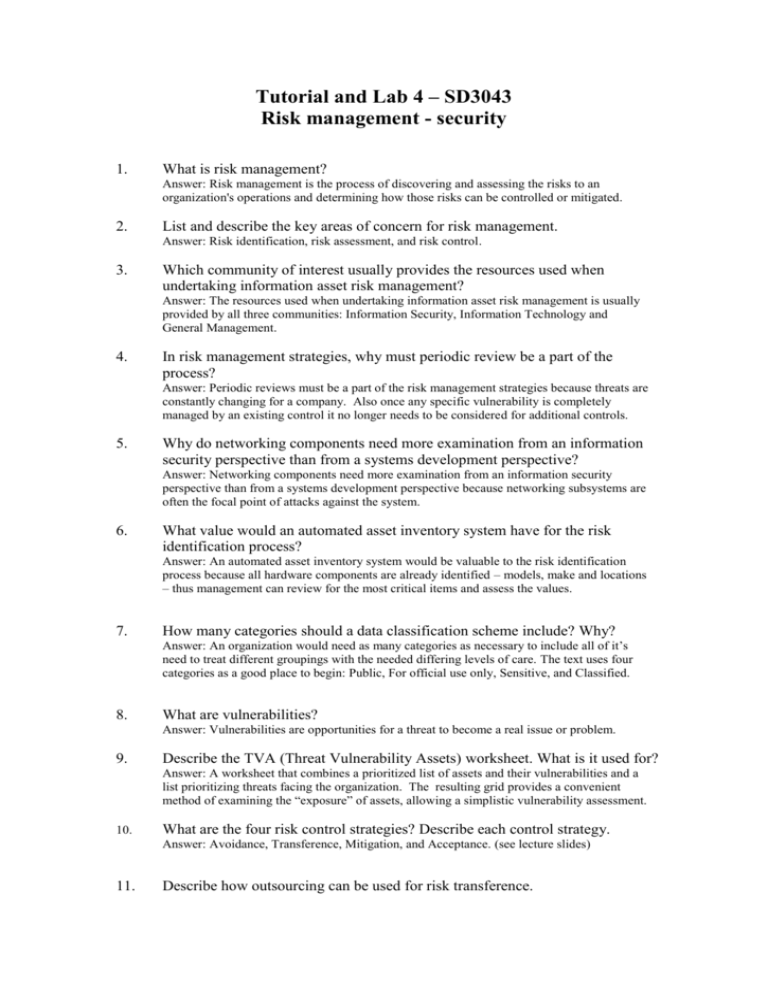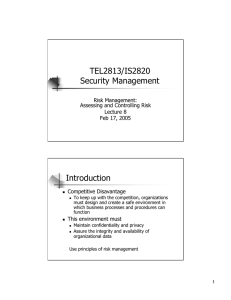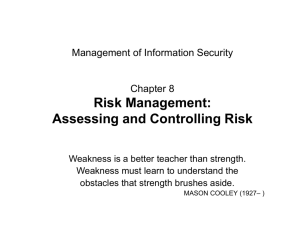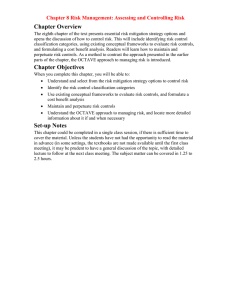Risk Management & Security Tutorial
advertisement

Tutorial and Lab 4 – SD3043 Risk management - security 1. What is risk management? Answer: Risk management is the process of discovering and assessing the risks to an organization's operations and determining how those risks can be controlled or mitigated. 2. List and describe the key areas of concern for risk management. Answer: Risk identification, risk assessment, and risk control. 3. Which community of interest usually provides the resources used when undertaking information asset risk management? Answer: The resources used when undertaking information asset risk management is usually provided by all three communities: Information Security, Information Technology and General Management. 4. In risk management strategies, why must periodic review be a part of the process? Answer: Periodic reviews must be a part of the risk management strategies because threats are constantly changing for a company. Also once any specific vulnerability is completely managed by an existing control it no longer needs to be considered for additional controls. 5. Why do networking components need more examination from an information security perspective than from a systems development perspective? Answer: Networking components need more examination from an information security perspective than from a systems development perspective because networking subsystems are often the focal point of attacks against the system. 6. What value would an automated asset inventory system have for the risk identification process? Answer: An automated asset inventory system would be valuable to the risk identification process because all hardware components are already identified – models, make and locations – thus management can review for the most critical items and assess the values. 7. How many categories should a data classification scheme include? Why? Answer: An organization would need as many categories as necessary to include all of it’s need to treat different groupings with the needed differing levels of care. The text uses four categories as a good place to begin: Public, For official use only, Sensitive, and Classified. 8. What are vulnerabilities? Answer: Vulnerabilities are opportunities for a threat to become a real issue or problem. 9. Describe the TVA (Threat Vulnerability Assets) worksheet. What is it used for? Answer: A worksheet that combines a prioritized list of assets and their vulnerabilities and a list prioritizing threats facing the organization. The resulting grid provides a convenient method of examining the “exposure” of assets, allowing a simplistic vulnerability assessment. 10. What are the four risk control strategies? Describe each control strategy. Answer: Avoidance, Transference, Mitigation, and Acceptance. (see lecture slides) 11. Describe how outsourcing can be used for risk transference. Answer: Outsourcing can be used for risk transference when an organization chooses to hire an ISP or a consulting organization to provide products and services for them like buying and configuring servers, hiring their own webmasters, web system administrators and even specialized security experts. This allows the organization to transfer risk associated with management of these complex systems to another organization that has experience in dealing with those risks. Benefit of outsourcing is that the provider is responsible for disaster recovery and through service level arrangements is responsible for guarantying server and website availability. 12. What conditions must be met to ensure that risk acceptance has been used properly? Answer: The following conditions must be met to ensure that risk acceptance has been used properly: the level of risk posed to the asset has been determined, the probability of attack and the likelihood of a successful exploitation of a vulnerability has been assessed, the annual rate of occurrence of such an attack has been approximated, the potential loss that could result from attacks has been estimated, a thorough cost-benefit analysis has been performed, controls using each appropriate type of feasibility have been evaluated, it has been decided that the particular function, service, information, or asset did not justify the cost of protection. 13. What is a cost-benefit analysis? Answer: A cost benefit analysis is an evaluation of the worth of the information assets to be protected and the loss in value if those information assets became compromised by the exploitation of a specific vulnerability. 14. What is the difference between benchmarking and baselining? What is the difference between due diligence and due care? Answer: Benchmarking is the process of comparing yourself versus other companies seeking the same results; base lining is the process of standardizing yourself with your own results. Due Diligence and Due Care occur when an organization adopt a certain minimum level of security. Independent Lab Exercises 1. Using the Web, search for at least three tools to automate risk assessment. Collect information on automated risk assessment tools. What do they cost? What features do they provide? What are the advantages and disadvantages of each one? Answer: The solution to this exercise will be unique for each student and will vary over time. 2. Read more details about the OCTAVE Method www.cert.org/octave/omig.html http://www.units.muohio.edu/mcs/information_security/Octave/vol1/whatisoct .html Write a short summary about this method.











